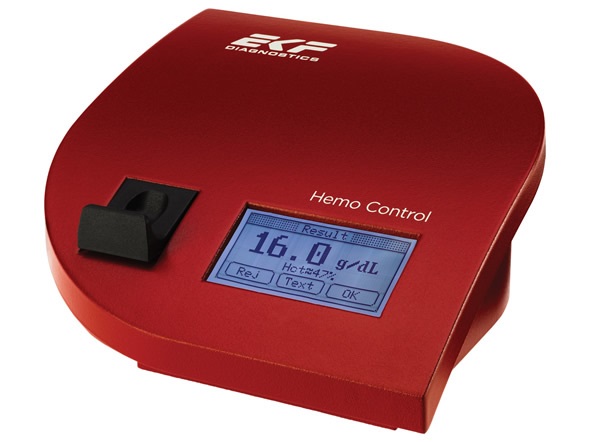Katja Lemburg discusses the next generation Hemo Control being launched in Europe at EuroMedLab, Paris 21-25th June. EKF will be exhibiting on Stand G005 (Level 1).
Could you please give a brief overview of the next generation Hemo Control point-of-care (POC) diagnostics analyser EKF Diagnostics has recently launched?
With our latest generation of Hemo Control Analyser we strengthen its position as a premium product in point-of-care haemoglobin testing.
We have enhanced data management and connectivity functions to ease the direct integration with the customer´s existing IT- environment, a request we are facing increasingly in the POC market.
The next generation offers a high degree of flexibility to meet the customer´s connectivity demands as they develop.
Hemo Control Hemoglobin Analyzer
What are the main applications of the Hemo Control?
Hemo Control is mainly used for POC testing of hemoglobin and hematocrit in primary care settings and blood banks.

Image Credit: EKF Diagnostics
Hemoglobin and hematocrit are key parameters in the diagnosis of anemia, the most common disorder of the blood with it affecting about 25% of the global population. Especially women in their child-bearing years and infants are susceptible to developing anemia.
In blood banks the level of hemoglobin is tested prior to donation to ensure the safety of the donor.
How accurate are the hemoglobin and hematocrit results from the analyser and how long does it take to perform the test?
Hemo Control delivers lab quality results. We guarantee a CV of ≤ 2% and a correlation with the NCCLS reference method of >0.98.
The typical measuring time is in the range of 25 to 60 seconds, depending on the level of hemoglobin in the sample. The hematocrit result is then calculated from the hemoglobin measurement.
How important is flexible connectivity?
When analysing the market situation we found that our customers are in very different stages with their requirements for connectivity, ranging from a single computer in a doctor´s office to a full, direct integration into lab information systems (LIS) in hospitals or web based solutions for disease screening programs.
There are numerous vendors for software solutions in healthcare and each have their specific interfaces. The new generation of Hemo Control devices use a public standard communication protocol (LIS2-A2) and a bi-directional interface. This allows a direct integration of the device with 3rd party software.
Could you please outline the Data Management ‘add pack’? What are the main additional functions this provides?
The new Data Management ‘add pack’ is used to upgrade a basic Hemo Control device with data management functions at a later stage. This is ideal for customers who are planning a future connection of POC devices to electronic patient records or LIS, but have not yet decided, or who would like to split the costs of investment. It helps them to keep their options open for upcoming connectivity requirements. In some countries electronic patient data management will become a general requirement in 2017.
The Data Management ‘add pack’ contains a barcode scanner, a licence key and connecting adaptor. The upgrade is performed through a simple web based registration process.
After the upgrade the device automatically supports the handling of patient and operator IDs, traceability of materials and QC schemes. On the Hemo Control Manager version of the device these features are supported from the beginning.
How many patient results can be stored on the Hemo Control?
Up to 4,000 patient results can be stored on the device. This facilitates the mobile use of the device. On data management enabled devices an additional 500 QC results can be stored.
What training is required for using the Hemo Control?
User friendly features ensure that very little training is required to use the Hemo Control. Step by step instructions on screen and a user-selectable language menu guide the user through the test procedure.
How does the Hemo Control compare to other products that are currently on the market?
Hemo Control combines excellent product quality with a high degree of user comfort and safety. The device operates accurately and reliably in a wide temperature range and its integrated re-chargeable battery lasts for up to 100 hours of mobile operation.
The new upgradeability and flexibility for data management and connectivity provides a unique market position.
Are there any more developments in the pipeline for EKF’s Hemo Control?
The near future developments will be to ensure the integration of Hemo Control with the most common middleware vendors for lab information systems.
What do you think the future holds for POC measurement of hemoglobin and how do EKF Diagnostics plan to contribute?
Globally, we see an increasing number of governmental or NGO supported anemia screening and nutrition programs. In most cases, anemia is easy to treat if adequate resources are applied.
We also see a move of point-of-care testing to alternative sites like pharmacies, nursery homes and mobile services. EKF offers a complete range of hemoglobin analysers to meet the requirements of different settings.
Where can readers find more information?
Please visit www.ekfdiagnostics.com or follow us on our social media platforms. We also offer webinars to update our business partners and users on new product features and applications.
EKF will be exhibiting Hemo Control at EuroMedLab Paris 21-25th June on Stand G005 (Level 1).
About Katja Lemburg
 Global Product Manager Hematology of EKF Diagnostics - Katja Lemburg graduated in Biomedical Engineering at the University of Applied Sciences Luebeck, Germany in 1997 with a focus on development of biosensors. After several years of working in sales and service of clinical research products, she joined EKF Diagnostics as Product Manager in 2008.
Global Product Manager Hematology of EKF Diagnostics - Katja Lemburg graduated in Biomedical Engineering at the University of Applied Sciences Luebeck, Germany in 1997 with a focus on development of biosensors. After several years of working in sales and service of clinical research products, she joined EKF Diagnostics as Product Manager in 2008.